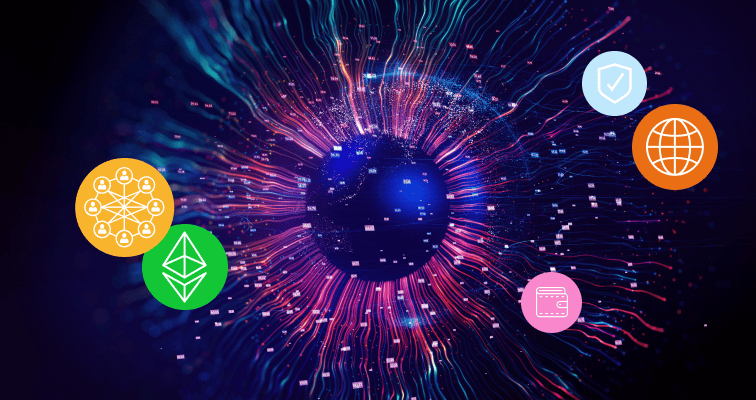Decentralized Finance (DeFi) or Open Finance movement is a decentralized financial system based on blockchain technology. It has begun to gain popularity and support due to its ability to make payments universally accessible to anyone.
DeFi allows its users to have a global, open alternative to every financial service used today. This includes saving accounts, loans, trading and insurance, and these are all accessible to you anywhere in the world — as long as you have a smartphone and an internet connection.

What exactly is DeFi?
Decentralized finance (DeFi) is a finance model that runs on
It operates using financial smart contracts, decentralized applications (DApps), and protocols on Ethereum, Solana, Stellar and other DeFi-enabled blockchains. Unlike Bitcoin, DeFi blockchain networks are highly scalable and usually have cheaper transactions.
Besides blockchain networks, DeFi transactions also happen on various decentralized platforms. These include decentralized exchanges (DEXs), lending and borrowing platforms, and yield farming protocols. It has also expanded to include other financial services, such as digital payments and insurance.
If you are a beginner thinking about how to invest in crypto and DeFI, keep reading to get the full details of how DeFi works:
| Smart contracts | Decentralized Applications (DApps) | Decentralized Exchange (DEX) |
|---|---|---|
| Smart contracts provide a platform for applications or scripts to run and create digital assets. This enables payments, transfers and other transactions to be authorized and completed irreversibly without the need for conventional “middlemen” such as banks. | A DApp is a software application that runs on a distributed peer-to-peer network rather than being hosted on a centralized server. It runs on a decentralized network such as Ethereum. | A decentralized exchange is simply an online trading platform like eToro, except that it is run by smart contracts on connected blockchains. Instead of trading only traditional |
How is DeFi different from traditional finance?
DeFi is different from traditional finance as there is less human error and more transparent, peer-reviewed transactions. However, some drawbacks can include slightly slower transaction speeds, and a lack of fallback if you accidentally forget your seed phrase.
- DeFi uses rules programmed in codes (smart contracts). Once your smart contract has been deployed onto the network, the connected DApp can run itself with minimum human interaction.
- Smart contracts are essentially
open source and can be audited by anyone. This results in a high level of trust among users since they can always check the contract’s code or find bugs. - DeFi and the DApps have improved accessibility that make it possible to process transactions across international borders or invest in DeFi services from any location.
- You can access your DeFi services from anywhere with an internet connection. However, you should confirm the crypto laws in your jurisdiction to avoid potential legal issues.
- DeFi is ‘permissionless’, which means that there are no middlemen to deal with or lengthy forms to fill out. Anyone can build or modify DeFi platforms – you can even build your own.
- Decentralized blockchains are slower than their centralized counterparts, and this may impact the DApps built on top of them.
- DeFi transfers all of the responsibility from the intermediaries to the user. If you accidentally transfer funds to the wrong address or forget the seed phrase to your crypto wallet, you’ll lose your money permanently.
- Unlike traditional finance, there is no bank customer support line you can call to reverse a transaction or regain access to your account.
- Using DeFi services can be quite challenging for beginners. One mistake can result in losing your funds forever.
Privacy is retained using DeFi since every transaction is not tied directly to your real-life identity.
What is DeFi currently being used for?
While still in its infancy, the potential use cases for DeFi are enormous. Besides DEXs supporting transactions, the main DeFi financial service is DeFi borrowing and lending.

These crypto loans allow lenders to earn
In a way, it is like the blockchain version of fintech peer-to-peer lenders. Now, let’s break down the two smart contracts that facilitate this service.
MakerDAO and DAI
MakerDAO is a smart contract that fulfills the borrowing function. It works by opening a collateralized debt position (CDP) staked using the trader’s preferred crypto (e.g., Ethereum or USDC). The asset then acts as collateral, and you can borrow funds in the form of a token called DAI, which is a stablecoin with a value equal to USD.
An annual interest rate called a stability fee is paid on the crypto loan, and it safeguards against overinflation of the total supply of DAI.
In a sense, MakerDAO acts similarly to a central bank by issuing DAI and also ensuring that its value remains stable. For example, if the supply of DAI increases too much and causes its value to fall below $1, MakerDAO will raise the stability fee (interest rate) to encourage those with active loans to pay back their debts.
Concurrently, the DAI token acts like a digitized version of the US dollar. While the Ethereum or USDC used as collateral is still subject to price swings in the crypto market, DAI can be counted on to remain at a 1:1 ratio with USD.
This creates a natural demand for DAI because it is both digital and stable, which makes it an ideal currency for online payments, in-game transactions, loans and much more.

Compound
Compound is another smart contract that offers both lending and borrowing services. Just like your savings account, you can deposit funds, which then accrue interest. The key difference is that your interest begins to compound from the moment your deposit hits Compound’s smart contract.
In addition, the interest rate you earn is typically higher than what traditional savings accounts offer as, being a smart contract, there are no operating costs or account management fees.
DAI and Tether are typically the most popular for deposits on Compound’s smart contracts. Usually, you can deposit DAI and exchange it for cDAI (cTokens). The deposit and the compound interest you accrue are then paid in cDAI. However, other cryptos, such as Ethereum and Basic Attention Token (BAT), can also be deposited.
Compound’s borrowing process works similarly to MakerDAO, with loans being secured by over-collateralization. When borrowers stake their coins or tokens with Compound, it increases their borrowing power. However, if their borrowing power falls below zero, their stake (collateral) is sold to cover the debt.
Final thoughts
There is no doubt that DeFi has the potential to evolve how global financial services operate in a similar way to how fintech ushered in the era of online banking and transacting that we take for granted today.
However, it is important to remember that blockchains and decentralization are not solutions for all financial-related issues. Identifying proper use cases that can truly benefit from this emerging technology will likely be the catalyst for mainstream adoption in the future.
Learn more about cryptocurrency on the eToro Academy.
FAQs
- Is DeFi the same as blockchain?
-
DeFi and blockchain are not the same. Blockchain is the technology on which DeFi operates and is used to manage financial transactions, while DeFi refers to the financial applications used to process decentralized transactions.
- Which cryptos are DeFi?
-
There are a wide variety of DeFi coins and tokens available. Some of the largest DeFi coins, ranked by market capitalization, include Avalanche, Uniswap and Chainlink.
This information is for educational purposes only and should not be taken as investment advice, personal recommendation, or an offer of, or solicitation to, buy or sell any financial instruments.
This material has been prepared without regard to any particular investment objectives or financial situation and has not been prepared in accordance with the legal and regulatory requirements to promote independent research. Not all of the financial instruments and services referred to are offered by eToro and any references to past performance of a financial instrument, index, or a packaged investment product are not, and should not be taken as, a reliable indicator of future results.
eToro makes no representation and assumes no liability as to the accuracy or completeness of the content of this guide. Make sure you understand the risks involved in trading before committing any capital. Never risk more than you are prepared to lose.


